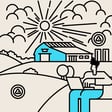Become a Creator today!Start creating today - Share your story with the world!
Start for free
00:00:00
00:00:01

Ep 5: What is a Subnet?
Connor Daly, Software Engineer at Ava Labs and known for having the 'most cats in crypto,' discusses the future of blockchain technology with Sylvia Sanchez from Owl Explains. In this episode, they delve into Ava Labs' innovative use of subnets to address blockchain's technological challenges, including complexity, scalability, and consensus speed. Learn how subnets allow for the creation of tailored blockchains adaptable to various projects and regulations. Connor also shares his experiences in quickly starting a subnet, its impact on wider adoption and innovation, plus a glimpse into his life with his beloved cats and plans for his growing animal family.
Find out more in our explainers at owlexplains.com
Transcript
Introduction to Owl Explains Series
00:00:06
Speaker
Hello and welcome to this Owl Explains Hootenanny, our podcast series where you can wise up on blockchain and web3 as we talk to the people seeking to build a better internet. Owl Explains is powered by Avalabs, a blockchain software company and participant in the avalanche ecosystem. My name is Silvia Sanchez, project manager of Owl Explains and with that I'll hand it over to today's amazing speakers.
Meet the Speakers: Connor Daly and Silvia Sanchez
00:00:33
Speaker
Hi, everyone. I am super excited to be here today. We have a really interesting topic with a very special guest. Today, we're going to be talking about subnets. And as most of you know, I will explain, this whole initiative is powered by Avalanche, and we're proud to be part of the Avalanche ecosystem. And we just had to talk about subnets and everything you can do with them. And today, we have got Connor Daly, software engineer at Avalanche, also known as the man with the most cats in crypto.
00:01:02
Speaker
Welcome, Connor. Great to have you here. Yeah, thanks so much for having me. I'm really excited to talk about subnets, crypto, cats, anything you can throw at me. Amazing. How many cats do you have, by the way? The correct answer is too many. But if you prefer a numerical answer, four. Okay, wow. And any plans on expanding the family or just staying outside?
00:01:26
Speaker
I'm looking at reducing before I expand. My fiance wants to, she's always bringing rabbits and other animals into the house and I'm like, too few animals has never been a problem that I've felt about my life in the last four or five years. Oh wow, I bet. Cats and rabbits, I'm sure there's lots of fun all the time. Yeah, thankfully the rabbits are fosters and they go home at the end of the month or whatever.
00:01:55
Speaker
The cats, you know, individual cats are not that much work, but when you have four, like there's always one of them that's got something going on at any given time. I have, they're all on different types of food. They're all on different meal schedules. I think I give out like 11 or 12 meals per day. Wow. It's a lot of work. I don't recommend four.
00:02:14
Speaker
Oh, wow. Well, forecast. All right.
What are Subnets?
00:02:17
Speaker
Well, let's kick off with the basics. So at all explains, we're all about understanding the technology, building a solid foundation. And in fact, that's the first branch of our tree of Web3 Wisdom, which if you haven't checked out, look it up on our website. There are five branches to guide the thinking of policymakers looking to regulate blockchain worldwide.
00:02:36
Speaker
So, now that we're on the first branch of the Tree of Wisdom, for our listeners who may not be super familiar with the concept, can you explain what subnets are and how they work?
00:02:46
Speaker
Yeah, absolutely. So it all comes down to blockchain scalability. And there's a lot of different approaches and ideas that people have for how to scale blockchains. How do we onboard the entire world onto blockchain? How do we make sure that we have enough chain capacity to handle the demands of the global financial system and the NFT ecosystem and everything else that comes along as a use case?
00:03:13
Speaker
And so Avalanche's approach to scaling blockchains is called subnets. So if you're familiar with this term, there's something known as vertical scalability and horizontal scalability. If you're familiar with what that means,
00:03:29
Speaker
Avalanche subnets are a form of horizontal scaling.
Building and Security of Subnets
00:03:34
Speaker
And so to kind of explain what I mean there is there's kind of two ways to make blockchains faster. One, you could have a single chain and make it faster and faster and faster. That would kind of be a vertical scaling approach. The horizontal approach would actually be to take a blockchain and split it into multiple parallel blockchains operating at the same time.
00:03:56
Speaker
And so that's kind of a horizontal approach. That's what Avalanche does. And so subnets are essentially a blockchain as a service technology that allows anyone to create their own blockchain on the Avalanche network.
00:04:11
Speaker
And when they do that, they get a lot of stuff for free. Because you can always go build your own blockchain by yourself without working with Avalanche. You could clone Bitcoin or Ethereum or whatever. But the reason that building a subnet is advantageous is because you get to be part of the Avalanche network. You get to take advantage of Avalanche consensus. You get to take advantage of Avalanche warp messaging to talk to other subnets.
00:04:37
Speaker
And so we actually make it so that you can spin up your subnet very quickly and cheaply and be part of the ecosystem where you're integrated with other subnets out of the box. So it's a much faster and easier process than building this yourself.
00:04:53
Speaker
Subnets are essentially this way of building your own blockchain, but also customizing that blockchain, not just creating another fork of the EVM, but also making changes to specialize for your use case. So that means tweaking some of the regulatory constraints so that your blockchain might be compliant in your jurisdiction.
00:05:16
Speaker
or tweaking the performance characteristics so that it is a better fit for your users. You might think about, do I want this chain to run a little bit more cheaply for me and more expensive for my users, or do I want to make it more expensive for me and cheaper for my users? These are some of the trade-offs that people can make to
00:05:38
Speaker
build their own chain and create an ecosystem of chains that work together to create effectively infinite capacity in the blockchain ecosystem and hopefully onboard the next billion blockchain users.
00:05:50
Speaker
Wow, that sounds amazing. So it all comes down to scalability and enabling people to take these advantages of being in the avalanche ecosystem and then just customizing it to whatever they may need. And what advantages do subnets offer in terms of securities? And security is a very big issue both for users and also when looking at it from a regulatory perspective. So what can you say about security and subnets?
00:06:14
Speaker
So this comes back down to what I mentioned earlier of when you build a subnet, you get a lot for free. At Ava Labs, we've been working on developing these subnet templates that allow users to build these chains out of the box and give them certain customizations that they can apply that
00:06:33
Speaker
We have, as marked as known safe, things that we've spent a lot of time and effort hardening. And we've put through the ringer and a lot of testing. So we have a fairly good idea that these different features work well. And you might sometimes hear these features called custom pre-compiles. The name's not too important. They're really just customizations. But they let you do some cool things. Like, for example, instead of just deploying a totally public chain that anyone can use, you can add
00:07:03
Speaker
a contract allow list or whitelist.
00:07:07
Speaker
that'll make it so that only the subnet operator or their specifically allowed parties or cooperators can deploy contracts on the subnet. So that means that only, instead if I create my DeFi chain, I don't have to worry about a bunch of random people on the internet deploying their own NFT projects on my chain. I can make sure that only the apps that I want running on my chain are running on my chain.
00:07:37
Speaker
And similarly, we can actually do the same thing for just interacting with the chain so that we can restrict who can access the chain at all to read from it or to write to it. So for example, if you wanted to set up kind of like a KYC blockchain, that's something that's possible on Avalanche where you onboard users one by one and basically you kind of have a strong gate where users have to go through some application process and then we give them the keys to the kingdom to interact with the chain. So we have a lot of
00:08:06
Speaker
features and customizations that we can use to control how does this chain work and who gets to participate, as well as getting all the benefits of the support of the main AvaLabs team who's been working on this for years and doing our best to harden the system so that anybody who participates will get a good implementation out of the box.
00:08:29
Speaker
Right. Wow. That sounds wonderful. And how does the consensus mechanism, the avalanche consensus specifically, contribute to the overall performance and reliability of
Avalanche Consensus and Blockchain Building
00:08:41
Speaker
subnets? Like why? What makes this consensus mechanism so great in part with the subnets? Like how do they function together?
00:08:48
Speaker
Yeah. So there's a lot of different hard problems in blockchains. There's a lot of different bottlenecks that can occur. But one bottleneck that's extremely important is the consensus bottleneck of how quickly can you make decisions? Because essentially, this is what consensus is for. You're trying to decide what block comes next. If I have a choice of three blocks, how do we decide if we go A, B, or C?
00:09:13
Speaker
And so that is one of the crucial bottlenecks in the system of performance. If you want to create blocks faster, you have to be able to pick your next block. And so this is where avalanche consensus really shines.
00:09:28
Speaker
And it allows us to scale significantly more than the other types of consensus, which the other types of consensus, if you're interested, there's something called like classical consensus, which is essentially kind of based on voting. And then there's Nakamoto consensus, which is the kind of Bitcoin proof of work longest chain.
00:09:47
Speaker
that some of your listeners may be familiar with. And so avalanche consensus is an entirely new branch of consensus algorithm that does very different things. It actually works by kind of like random sampling.
00:10:00
Speaker
And it has a lot of the benefits of both classical and Nakamoto at the same time without a lot of the trade-offs. There are some catches, but basically it allows us to overcome one of the biggest bottlenecks in blockchain computing.
00:10:19
Speaker
The really nice thing here is, like I keep mentioning, is that it's something that you get for free by working on Avalanche, by building a subnet. You don't have to worry about making decisions about your consensus algorithm or
00:10:34
Speaker
building any of this from scratch. It's all provided for you by building a subnet. When you build a subnet, you just need to focus on your application logic. You don't need to build this entire networking consensus infrastructure underneath you. And it really cuts down the work for builders in this space. Wow, that's wonderful. So I guess users a lot of freedom. It's sort of like
00:10:56
Speaker
You've already done the hard work. You've already plowed the field and people can just go and use the soil and build whatever they want to build without doing so much of the complicated things. It seems like it's a really much more convenient way for people to take the advantages of the avalanche blockchain of this ecosystem but to customize it to their needs without having to worry so much about all the nitty-gritty.
00:11:20
Speaker
Yeah, that's exactly it. I mean, there's not that many people in the world who are good at building blockchains right now. It's a very small field, and we're very lucky to work with some of the best people on the planet at Ava Labs right now. And our goal is to figure out ways that we can do the hard work for the customer, because there's a lot more people who want blockchains than there are people who are good at building blockchains from scratch.
00:11:48
Speaker
And so our goal right now is to figure out, you know, how can we make it so that you can be successful regardless of your skill level, that anybody who comes in with a little bit of web to engineering experience and who knows how to use kind of basic cloud computing, how can they have follow a happy path to get their perfect subnet without having to spend a year going deep into, you know,
00:12:15
Speaker
the world of blockchains, the world of this kind of custom development. And so we're really trying to take away that burden. Totally. I loved what you said about the fact that there are so many people wanting to build blockchains, but very few of them are good at building them from scratch because it entails a lot of things. So avalanche subnets are not only very safe, but also they save time.
00:12:38
Speaker
for all those wanting to build on these blockchains. And following that thought, I wanted to ask you what role do validators play in the operation of avalanche subnets and how are they incentivized to maintain the network?
00:12:52
Speaker
Yeah, that's a really great question. So when you kind of think about what I've talked about what subnets do, but I haven't necessarily really talked about like what they are. And they really are composed of two different things. One is a validator set and the other is a virtual machine.
00:13:09
Speaker
So basically, the virtual machine just is a rule set that defines what happens in each block. What are the rules of the chain as far as what constitutes a transaction? What happens when there's a new block? What happens when there's a new transaction? That's what a virtual machine is. The other key piece is the validator set, which you just mentioned.
00:13:31
Speaker
So the validator set is who gets to participate in consensus, who gets to decide what the next block is. And this is where we actually get into some pretty cool stuff that Avalanche does, and I haven't really seen other people be able to do. And Avalanche has configurable validator sets for subnets. So what does that mean? So this means that you can pick and choose who participates in your chain.
00:13:56
Speaker
And the cool thing about this is we used to live in this world where there are public blockchains and private blockchains, and there's no middle ground. It's a very binary world, but now we have the ability to make this programmable. We have the ability to, say, assign arbitrary rules to who can participate.
00:14:21
Speaker
And so instead of just having to be manually whitelisted, you can do things like saying, only US citizens can be a validator. Or only EU citizens can be a validator for this subnet. And only EU citizens can participate in this blockchain. Or you could say that only members of my company can do this. So we have the ability to create these extensible
00:14:48
Speaker
rule sets for who gets to be a part of the chain and who performs the safety operations to make sure that the chain is secure. There's something called Byzantine fault tolerance in computer science. And this means you frequently might read that blockchains are these Byzantine systems. And what that means is that
00:15:13
Speaker
we assume that there's a number of bad actors working in the space. And you make some assumptions about how many there are. And you might say that the system is secure as long as 51% of the actors are honest and not trying to cheat. And so when you're building these systems, you actually do care about what's the percentage of bad actors. And so it makes total sense to me that regulators might be interested in
00:15:41
Speaker
you know, can we make sure that for our chain, we can define, you know, what is good behavior. And we want to make sure that all the participants are people we trust. And if you're the US government, you might say, we only trust US citizens, or we only trust NATO signatory governments or something like that.
00:16:03
Speaker
So in this case, it's a very cool thing for us to be able to say, yes, we support that. We support the ability to create a system where you can control who gets to determine the security of your network. And alternatively, if you want to build a small private network for an internal company, if I'm JP Morgan or whoever,
00:16:26
Speaker
I can just say like, okay, I'm going to have my internal finance blockchain, but I'm not going to expose it to the outside world because I don't necessarily want anybody on the internet to be able to just see what we're doing internally. But I want everyone that I give access to at the company and maybe some trusted partners to be able to work with us and be part of this system. And so our validator set flexibility is incredibly important to the future of Avalanche.
00:16:54
Speaker
and how we scale to meet every organization's needs and not just the needs of the US market public blockchain world. Right. So very wide application. I love that.
Interoperability and Use Cases
00:17:08
Speaker
And following that thought, so how do these subnets ensure interoperability with other blockchain networks, you know, of other ecosystems? What applications would this essentially have for the broader Web3 ecosystem as a whole?
00:17:25
Speaker
Sure. This is the rub. This is the hard part about subnets, is because you're running all these chains in parallel, you lose out on some of the benefits of running everything on the same chain. And typically, we call this interoperability. And this is where you can do some really cool stuff, like how do I, or I guess, how do I, in one transaction, change my
00:17:51
Speaker
Bitcoin to Ethereum and then take out a loan against that Ethereum and then swap that loan to USDC then pay off Do you know do this attack and then you know swap it back and trade back? And so, you know, those are some like really complicated things that you can do when all of your apps are running together but when you talk about a world of subnets and many blockchains you lose that interoperability and so
00:18:15
Speaker
That's kind of like the key question for subnets is how can we reconstruct that? How can we make it look like we're running in a single universe even though we live in this multi-chain world? And it's like a problem that we've seen in other areas of computer science before. This is the single-processor, multi-processor kind of problem too of when you're back
00:18:37
Speaker
20 years ago, computers used to have just a single, single processor, and everything was kind of in one stream of execution. But now we live in this multi-parallel processing world where you have multiple processors and they have to talk about how do we share memory? How do we understand what the other processor is doing? So we've seen these problems before in computer science, but they're kind of hard to figure out.
00:19:03
Speaker
What we've been working on at Ava Labs is something called avalanche warp messaging, which is a protocol for talking between subnets and exchanging messages and exchanging data so that applications on one subnet can actually call applications on another.
00:19:19
Speaker
And you can use that to make bridges or any other application. But so we have some very specific implementations that we're working on within the Avalanche ecosystem so that all subnets can talk to each other and get the benefits of being inside the Avalanche ecosystem. That being said, we're still very interested in the rest of the world because we know the rest of the world is not just Avalanche. There's also Ethereum. There's also Cosmos.
00:19:47
Speaker
Polkadot, Solano, whatever. And so we do integrate with those technologies as well, but through a less native solution. And mostly we've worked with third parties on this. So this is where bridges come in handy. If anybody's not super familiar, bridges are just ways for their apps that you can move tokens from one blockchain to another. They have their faults.
00:20:13
Speaker
but they're a necessary component and they're getting better and we have a quite good bridge in the avalanche bridge.
00:20:21
Speaker
So yeah, so we have applications like bridges, and then there's some more generic messaging protocols. Something like Layer Zero Labs is very commonly used across the space. But yes, so interoperability is a really important problem. And we have really good solutions within the Avalanche network. And there's some more less good solutions connecting Avalanche to the rest of the world. But it's still a very important problem space. Indeed. Wow. And I love how you also outlined the different approaches that are being taken to
00:20:51
Speaker
to access other networks and have this interoperability. Obviously, you can't have everything super perfect right at the beginning, but I love that there are avenues, that there are ways. And can you walk us through a recent use case or application of avalanche subnets that you think is particularly interesting? Like how did this use case in particular demonstrate the benefits of the technology of using subnets?
00:21:18
Speaker
Yeah, sure. So one use case that's been, oh, man, there's two that I want to talk about. So I'll kind of maybe give a brief overview of both. So the first is GameFi. So if you've never heard this term, you know, Web3 Gaming, GameFi, it's super popular. It really took off in the last
00:21:37
Speaker
a couple years. So originally it kind of started out as mobile games trying to kind of tokenize some of their in-game assets and make them available on secondary marketplaces. But now basically we're seeing this whole wave of video games trying to integrate blockchain in a lot of different ways. And so we're super excited about this because
00:22:04
Speaker
We're getting beyond the super fast moving Southeast Asian mobile game studios to some of the rest of the world is really starting to catch up. And we're seeing AAA game developers building in this space. And so one that I would like to highlight is called Trapnal, who I think they're doing an incredible job. I'm so excited for their game to come out. But that's looking at how do we
00:22:36
Speaker
make assets in our game actually owned by the players and not owned by us, the company. And it's all about decentralizing ownership of the game assets so that if you earn something in a game, it's really yours and it can't be taken away from you. And this is kind of like a funny story if you listen to Vitalik talk about Vitalik Buter and the founder of Ethereum.
00:22:58
Speaker
talk about what his motivation for getting into crypto was, it actually had to do with World of Warcraft. And the game developers of World of Warcraft tweaked some of the rules of the game, and it nerfed his favorite weapon. It made his favorite weapon in the game bad, essentially. And he was so mad about this that he was just like, there must be another way.
00:23:26
Speaker
And so this is kind of actually an attempt at doing that. This is a way to give all of the items in a game over to the players that they control them and they can trade with them.
00:23:38
Speaker
and move them between different players and have secondary markets for them. So I'm super excited to see what they do. I think games are a huge area of innovation, and there's people playing with all kinds of different models. I would be lying if I said, we know what the best way, we know what the exact future is going to look like, because we're still very much in the exploration phase.
00:24:00
Speaker
But the reason that they work so well on subnets is because games have really high performance requirements of
00:24:10
Speaker
This is one of those things you talk about latency of like how fast is the game. And if it takes too long for a match to load, people leave. You have to be real time. You can't make people wait. If you watch video game reviews, people are always talking about like, the servers take too long to load. That's like an absolute killer for these studios. So they need the lightning performance that you can really only get by having a dedicated subnet for your system.
00:24:37
Speaker
And also they need a lot of control over gas tokens and like how the users will be able to spend money. How can they onboard users without having them needing to go to Coinbase, KYC-ing for a week, figuring out how to use Core or MetaMask or any of these wallets to withdraw their tokens. That's far too much work. So they need to be able to onboard people instantly. And that's something that Avalanche really provides.
00:25:01
Speaker
And then the other thing I'll highlight just very briefly is customer loyalty programs. We've had a lot of success in the last few months in particular, especially in Korea with SK Planet of one of the largest companies in Korea.
00:25:19
Speaker
trying to tokenize their loyalty programs. It's like your Starbucks points, your airline miles, trying to actually let users own those so that
00:25:33
Speaker
Again, it's not the company in charge. These points can never expire. You're the one in control of them. You can choose what you want if you want to transfer them to other people. Putting customers in charge of their loyalty programs and making sure that people actually feel ownership over them is something that these companies have found.
00:25:51
Speaker
a lot of success with and are incredibly excited with and we're at the very start of our journey with those companies but they've been extremely excited about this and we're really eager to work more with them so that's something that's definitely going to be coming out in the near future when we've had a lot of great partnerships there so we're excited to do more.
00:26:10
Speaker
That's amazing. Great examples. I love how they're both super different, but also super relevant. Like with gaming, it's all about the essence of Web3, right? Distributing value to the users and all about that true decentralization.
Role of Regulators in Subnet Development
00:26:24
Speaker
And with the customer loyalty programs and the miles, I think that's a very big hassle for a lot of us. Like just this morning, I was literally trying to redeem some of the miles.
00:26:34
Speaker
but the terms and conditions were so annoying that I lost like 10,000 miles and I was like I might as well just buy the flight with dollars and help with miles but hopefully you know like we have more of these airlines and programs onboarding onto subnets and really using this technology which will ultimately make everything easier both for them it makes everything faster but also for users and I think that is a great incentive for
00:26:57
Speaker
for companies because once you have that really safe, scalable system, more users will want to use whatever you're providing and will also make it easier for you. I think it's a win-win process, essentially. Now that we've seen all of these, like what are subnets, what can we do with them? What role can regulators play in shaping the development and adoption of subnets? What can the blockchain industry do to facilitate
00:27:25
Speaker
collaboration, and open communication with regulators? Yeah, I think this is a really important question, especially over the last year. We've really seen that there's a lot of lack of clarity around what constitutes a security, what constitutes
00:27:47
Speaker
good practice for on-chain finance. From my perspective, the most important thing that we need to figure out is coming up with good processes to
00:28:01
Speaker
bring new products to market. And figuring out, you know, people like tokens, people like NFTs, but we're not always sure what they are. And so there's so much innovation in this space, and there's so many people that want to be compliant. Nobody, you know, the amount of people that I talk to that are just like, you know, screw you, regulators, we want to do what we want, those people are like almost non-existent.
00:28:22
Speaker
What people really want is just clear guidelines for how to be compliant so that they can do what they need to do in a way that does not take two or three years to go to market. Just creating systems that are up to date with the current times so that we can come in
00:28:42
Speaker
and say, OK, I want to launch a new token. I would like to sell to US customers. I'd like to register. I would like to prove that I'm not a Ponzi. I would like to do all these things. So just let me know what I need to do. And I would be happy to do them because most of the people operating in this space are trying to run legitimate businesses. And a lot of times, there just is no guidance for them for how to be compliant. And so they only have to guess or just kind of make things up as they go along, which can be harder to actually
00:29:13
Speaker
which can eventually lead to some bad outcomes because I think there are so many good people in the space that are interested in building good products that far outweighs the bad. And I think I would just say the best thing we could do is empower them to do things the right way.
00:29:31
Speaker
As far as for subnets in particular, I think there's some really interesting stuff. I know the government themselves is actually very interested in learning about these technologies, integrating them into their own processes as well. I know we've worked with the state of Florida and FEMA, Federal Emergency Management Association, to
00:29:54
Speaker
start tokenizing some of their payment programs, I believe, and for their payouts, which I think is really cool. And there's been a lot of interest from various state and federal agencies in getting blockchain systems in place to help them. So I think the more that these people learn about the technology, the more that we'll be able to develop better systems to put them into production. So I'm really excited about that as well.
00:30:23
Speaker
Absolutely. I think that's a great takeaway. And yeah, do you have any closing comments, any learning recommendations?
Resources and Closing Remarks
00:30:31
Speaker
Where can people go to if they want to learn a little bit more about subnets? I think this was a very good foundational 30 minutes of extracting subnets. Yeah, but for those of us who are curious, where might be a good place for them to learn more about this amazing technology and what's happening within this ecosystem?
00:30:50
Speaker
Well, there's a lot of good resources out there now. I'll say a lot of them are mine. My selfish plug. So yeah, definitely check out my Twitter account. I am dosconner on Twitter, D-A-S underscore C-O-N-N-O-R. I've actually done a lot of writing about subnets and about Avalanche and building in crypto, learning about crypto development, aimed at very intro level pieces. So if you're interested in those, highly recommend checking those out. I also used to be a part of a podcast called The Subnet Show.
00:31:21
Speaker
And we've done several episodes that were deep dives on subnets and different aspects on subnets. So we're not making any new episodes right now. But if you're interested in just learning some more of where we talk about the technical aspects of subnets for an hour or two on a couple of different episodes, I highly recommend checking those out as well. They're very useful.
00:31:44
Speaker
Would recommend just following Patrick O'Grady is another great Twitter follow He's constantly tweeting about the latest and greatest and subnets tends to be from a more technical perspective I tend to write from a more beginner's perspective. So You know official channels as well avalanche medium avalanche Twitter are very
00:32:08
Speaker
places to get the latest news and updates on partnerships. And we recently expanded our developer relations team quite significantly. So we've gone from like one to four, four or five people right now. So we're planning on doing a lot of technical writing in the next year to just kind of bring these concepts more into the public consciousness and really explain them for everyone so that anybody can understand. My focus in particular is very much on how do we onboard
00:32:37
Speaker
the next generation of folks without having to make them jump through all the hoops that I did. How do we make it easy so that anyone can understand? So that's really something that I care deeply about. So hopefully somewhere in there you can find something useful.
00:32:53
Speaker
Wonderful, yes. And we'll be definitely reposting some of your content there on the I Will Explains Twitter account, linking them to your Twitter. Because just opening your Twitter profile, there was an amazing thread of so many things explained. I think it was just like different things that you could just click on and you continue reading, like I personally love.
00:33:11
Speaker
what you write on Twitter. So we'll also do some retweeting for that so that it's easier for our listeners to find it. And yeah, thank you so much, Connor, for this amazing conversation. I also learned a lot just hearing your chat about subnets and answer the questions. So thank you for your time. And that's a wrap. Yeah, thank you so much for having me. Really appreciate it.
00:33:36
Speaker
We hope you enjoyed our Hootenanny. Thank you for listening. For more Hootful and hype-free resources, visit www.owlexplanes.com. There, you will find articles, quizzes, practical explainers, suggested reading materials, and lots more. Also, follow us on Twitter and LinkedIn to continue wising up on blockchain and Web3. That's all for now on Owl Explains. Until next time.



















